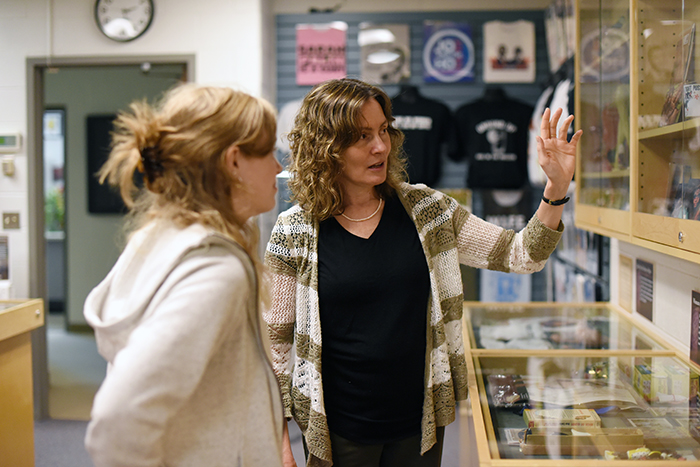
Ferris Museum of Sexist Objects co-founder and History professor Tracy N. Busch is
pictured here inside the museum on the Big Rapids campus of Ferris State University.
Ferris State University faculty members and advocates are working to expand the message and mission of the Ferris Museum of Sexist Objects by nurturing discussion in the region and beyond.
MoSO co-founder and History professor Tracy N. Busch said the museum’s emphasis is more on telling stories than focusing on its objects.
“We have gathered responses from those who are struck by items they viewed in our collection, as we believe these messages can be valuable and encouraging to people of all ages,” Busch said. “We feel the MoSO is more of a movement than a museum, so we want to take our objects and message out into the community.”
A “Mini-MoSO” was curated as Busch consulted with Carrie Weis in Ferris State’s Fine Art Gallery, and the MoSO Storytelling Community had its beginning in Fall 2022. Busch said a student storytelling pilot project brought a significant response.
“They followed our vision, which encouraged us to continue seeking out more stories,”
Busch said. “Our curated items allow us to travel with our story and gather responses
from a more diverse audience.”
Busch said another initiative for the committee is to create content that tells the
story of Anna Howard Shaw, a suffrage leader in the late 19th century and early 20th
century.
“The idea that Shaw came from England to rural Big Rapids as an adolescent, and by her life experiences grew to lead the largest suffrage association in the United States remains an important story worth sharing,” Busch said. “Our founder, Woodbridge Ferris, kept her portrait in his office, saying he was a ‘radical advocate’ for the women’s rights causes she promoted. That was not a popular stance to take, at that time.”
The museum’s intentions also reach to dialogue and debate on discriminatory practices beyond sexist attitudes, and Busch said committee member Mari Kermit-Canfield’s skills in gamification of societal issues are being applied to develop an exercise in examining intersectionality.
“We hope to illustrate notions of bias that pertain to social class, racism and sexism,” Busch said. “Game players can see what gives them social ‘value,’ in terms of their employment status and social acceptance. By making use of innovative educator Sylvia Duckworth’s ‘Wheel of Privilege,’ along with Kimberle Crenshaw’s presentations on intersectionality’s layers of oppression, our hope is to give participants the opportunity to see where sexist and other obstructive practices exist and might be avoided.”
The Ferris Museum of Sexist Objects strives to raise awareness and inspire activism in response to everyday items that promote sexism, gendered violence and female stereotypes. The Museum is a learning environment that works to encourage scholarly dialogue and fosters research.

